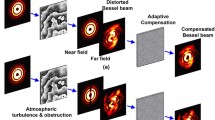Abstract
A communication system, where data is transmitted in the form of light using optical source like laser over the atmospheric channel, is called as a free space optical (FSO)-based communication system. Due to the presence of atmospheric turbulence also known as wavefront aberration, coupling efficiency of transmitted laser signal decreases at the receiving terminal which results into poor BER (bit error rate) performance and system link range. To compensate this loss due to wavefront aberration, adaptive optics (AO)-based sensor-less AO system is treated as an important technique in FSO system to deliver improved performance in the presence of strong scintillation. In this research, an oppositional-breeding artificial fish swarm (OBAFS) algorithm is proposed for the compensation of wavefront aberration in sensor-less AO system. Using this proposed algorithm, optimum voltage or control signal of the actuators in deformable mirror (DM) is selected optimally. By selecting these control parameters, incident wavefront aberration is compensated and performance of FSO communication system gets improved. Simulation results prove that this newly proposed compensation technique performs better than the existing popular compensation techniques like stochastic parallel gradient descent (SPGD) algorithm and artificial fish school algorithm (AFSA) in terms of performance parameters like Strehl ratio (SR), root mean square (RMS) value, coupling efficiency as well as convergence speed.






Similar content being viewed by others
References
H. Kaushal, G. Kaddoum, Optical communication in space: challenges and mitigation techniques. IEEE Commun. Surv. Tutor. 19(1), 57–96 (2017)
N. Kumar, V. Khandelwal, in Simulation of MIMO-FSO system with gamma-gamma fading under different atmospheric turbulence conditions. IEEE-Inter. Conf. on Signal Processing and Comm., ICSC-19 (2019). https://doi.org/10.1109/ICSC45622.2019.8938233
N. Agrawal, C. Davis, S. Milner, in Free space optical sensor networking for underwater sensing applications. Inter. Conf. on Intelligent Sensors, Sensor Networks and Information Processing, ISSNIP-2009 (2009)
M. Dabiri, H. Savojbolaghchi, S. Sajad-Sadough, in On the ergodic capacity of ground-To-UAV free-space optical communications. 2nd West Asian Colloquium on Optical Wireless Comm., WACOWC-2019 (2019)
X. Li, T. Geng, S. Ma, Y. Li, S. Gao, Z. Wu, Performance improvement of coherent free-space optical communication with quadrature phase-shift keying modulation using digital phase estimation. Appl. Opt. 56(16), 4695 (2017)
Z. Rizou, K. Zoiros, A. Hatziefremidis, in Signal amplitude and phase equalization technique for free-space optical communications. 15th Inter. Conf. on Transparent Optical Networks, ICTON-2013 (2013)
S. Navidpour, M. Uysal, M. Kavehrad, BER performance of free-space optical transmission with spatial diversity. IEEE Trans. Wirel. Comm. 6(8), 2813–2819 (2007)
R. Wang, Demonstration of horizontal free-space laser communication with the effect of the bandwidth of adaptive optics System. Opt. Commun. 431, 167–173 (2019)
C. Liu, M. Chen, S. Chen, H. Xian, Adaptive optics for the free-space coherent optical communications. Opt. Commun. 361, 21–24 (2016)
J. Cao, X. Zhao, Z. Li, W. Liu, H. Gu, Modified artificial fish school algorithm for free-space optical communication with sensor-less adaptive optics system. J. Korean Phys. Soc. 71(10), 636–646 (2017)
L. Zhaokun, J. Cao, X. Zhao, W. Liu, Swarm intelligence for atmospheric compensation in free-space optical communication—modified shuffled frog leaping algorithm. Opt. Laser Tech. 66, 89–97 (2015)
D. Zhang, S. Hao, Q. Zhao, Q. Zhao, L. Wang, X. Wan, Wavefront reconstruction method based on wavelet fractal interpolation for coherent free space optical communication. Opt. Commun. 410, 723–729 (2018)
M. Li, M. Cvijetic, Coherent free space optics communications over the maritime atmosphere with use of adaptive optics for beam wavefront correction. Appl. Opt. 54(6), 1453 (2015)
J. Cao, X. Zhao, Z. Li, W. Liu, Y. Song, Stochastic parallel gradient descent laser beam control algorithm for atmospheric compensation in free-space optical communication. Optik 125(20), 6142–6147 (2014)
L. Wei, W. Shi, B. Wang, K. Yao, Y. Lv, J. Wang, Free space optical communication performance analysis with focal plane based wavefront measurement. Opt. Commun. 309, 212–220 (2013)
X. He, X. Zhao, S. Cui, H. Gu, A rapid hybrid wave front correction algorithm for sensor-less adaptive optics in free-space optical communication. Opt. Commun. 429, 127–137 (2018)
L. Zhaokun, J. Cao, X. Zhao, W. Liu, Atmospheric compensation in free-space optical communication with simulated annealing algorithm. Opt. Commun. 338, 11–21 (2015)
Y. Gao, L. Guan, T. Wang, Y. Sun, A novel artificial swarm algorithm for recalibration of fiber optic gyroscope errors parameters. Sensors 15, 10547–10566 (2015)
L.X. Li, Z.J. Shao, J.X. Qian, An optimizing method based on autonomous animats: fish-swarm algorithm. Syst. Eng. Theory Pract. 22(11), 32–38 (2002). https://doi.org/10.12011/1000-6788(2002)11-32
K. Rajkumar, M.K. Jeyakumar, Multi-objective based adaptive meta-heuristic algorithm for optimal multicast route selection in wireless ad-hoc network. Int. J. Eng. Adv. Tech. 09(01), 6721–6729 (2019)
H.R. Tizhoosh, in Opposition-based learning: a new scheme for machine intelligence. IEEE- Inter. Conf. on Computational Intelligence for Modelling, Control and Automation and International Conference on Intelligent Agents, Web Technologies and Internet Commerce, CIMCA-IAWTIC'06 (2005)
Author information
Authors and Affiliations
Corresponding author
Additional information
Publisher's Note
Springer Nature remains neutral with regard to jurisdictional claims in published maps and institutional affiliations.
Rights and permissions
Springer Nature or its licensor holds exclusive rights to this article under a publishing agreement with the author(s) or other rightsholder(s); author self-archiving of the accepted manuscript version of this article is solely governed by the terms of such publishing agreement and applicable law.
About this article
Cite this article
Kumar, N., Khandelwal, V. Compensation of wavefront aberration using oppositional-breeding artificial fish swarm algorithm in free space optical communication. J Opt 52, 1370–1380 (2023). https://doi.org/10.1007/s12596-022-00947-4
Received:
Accepted:
Published:
Issue Date:
DOI: https://doi.org/10.1007/s12596-022-00947-4




